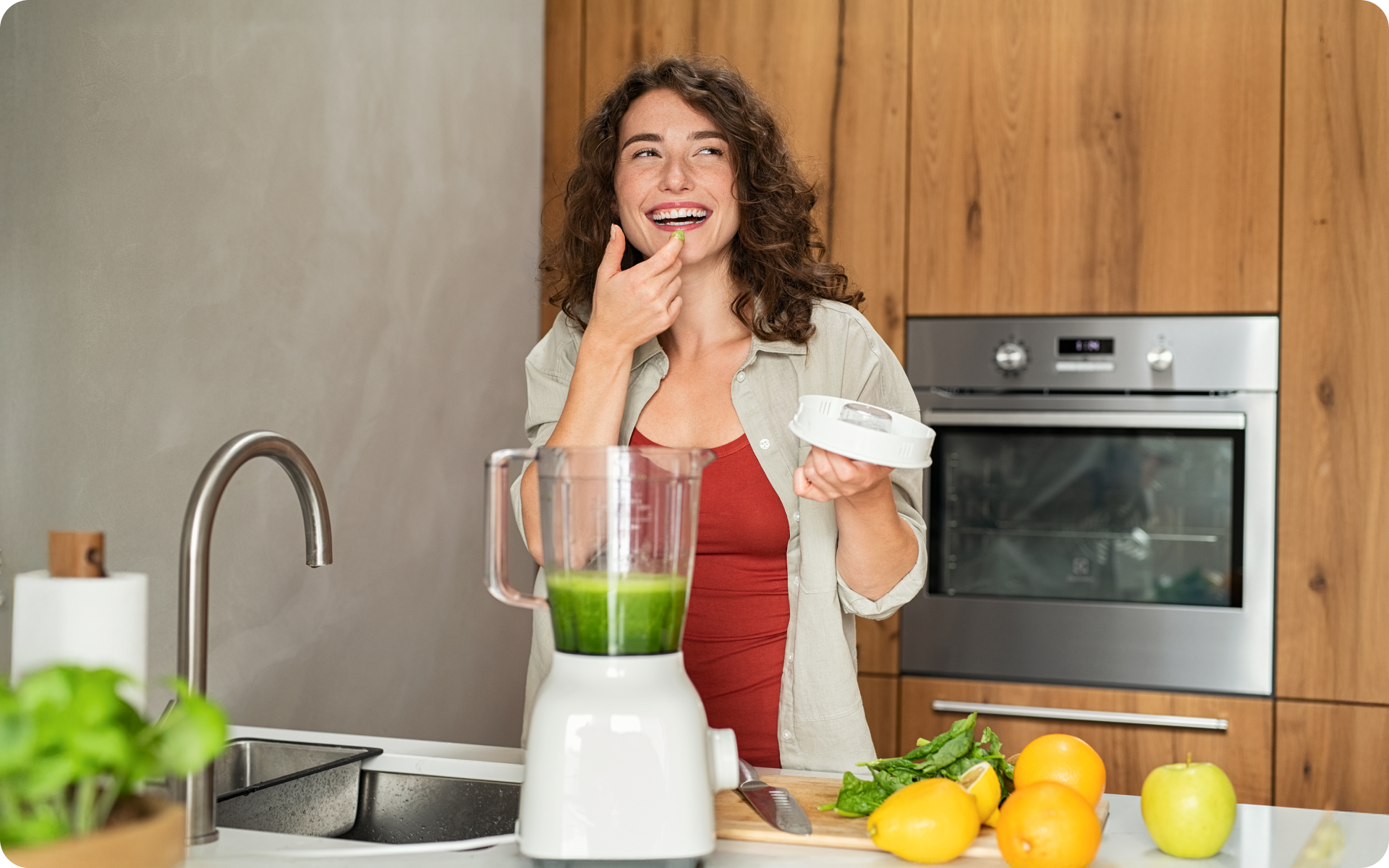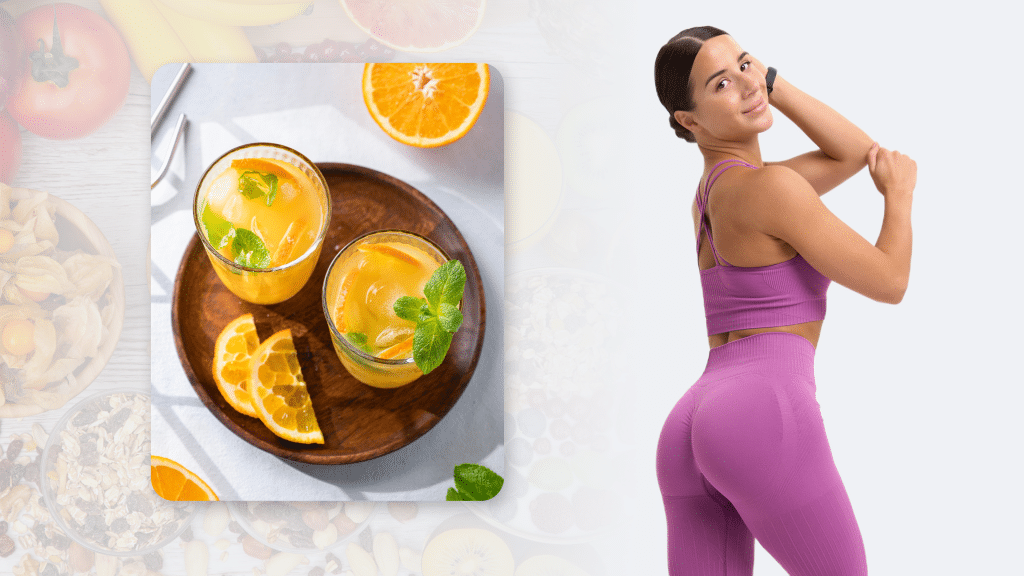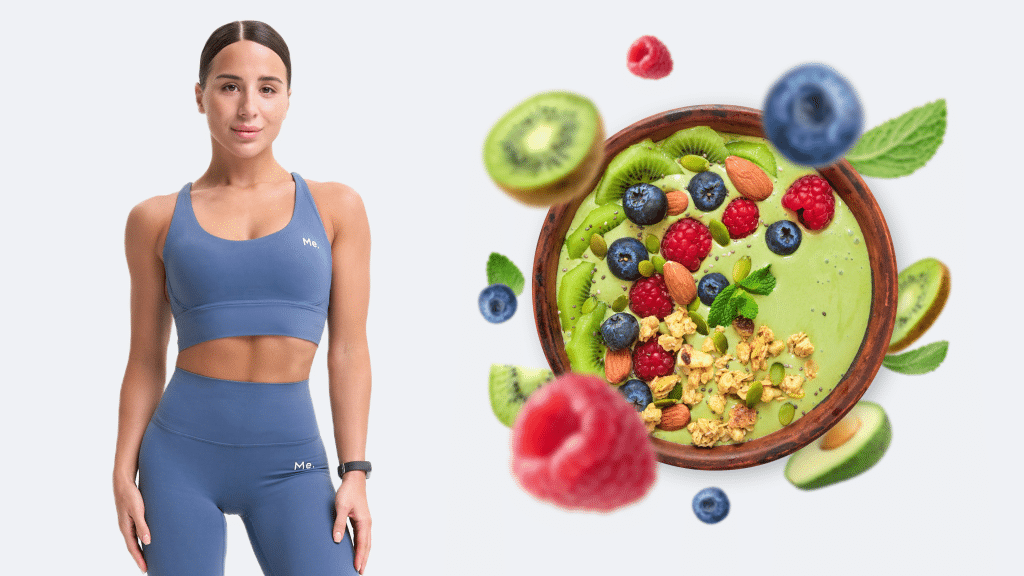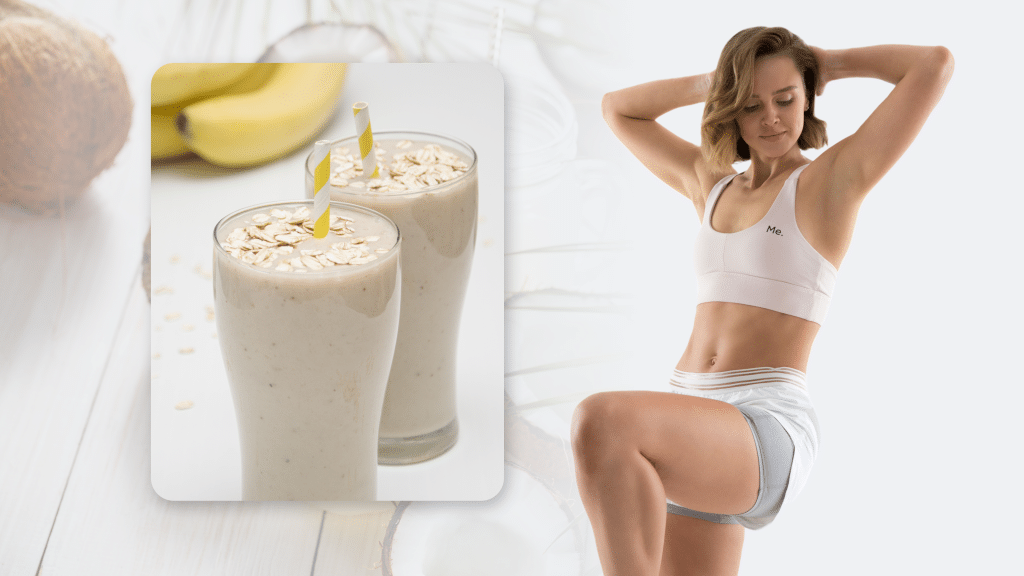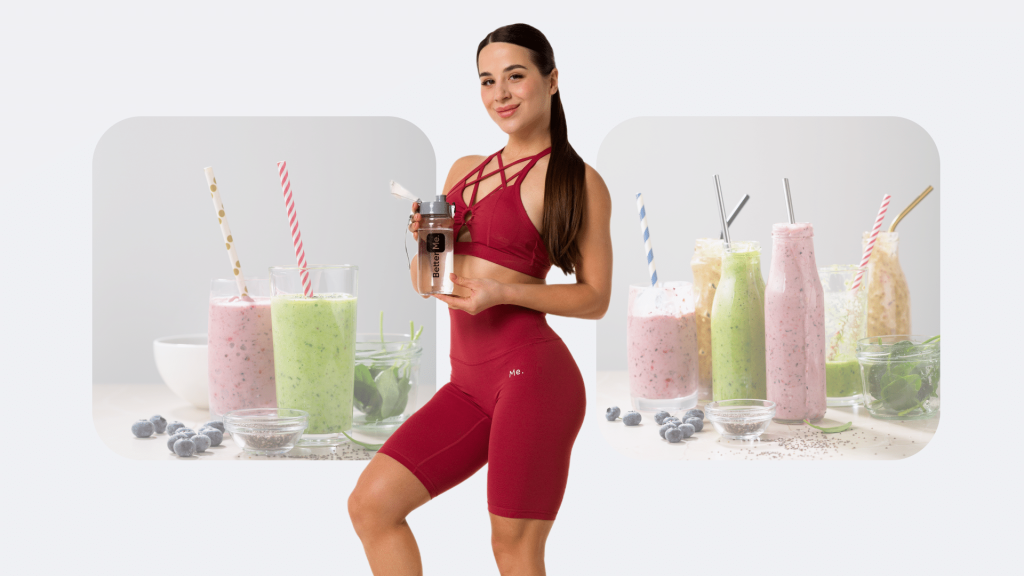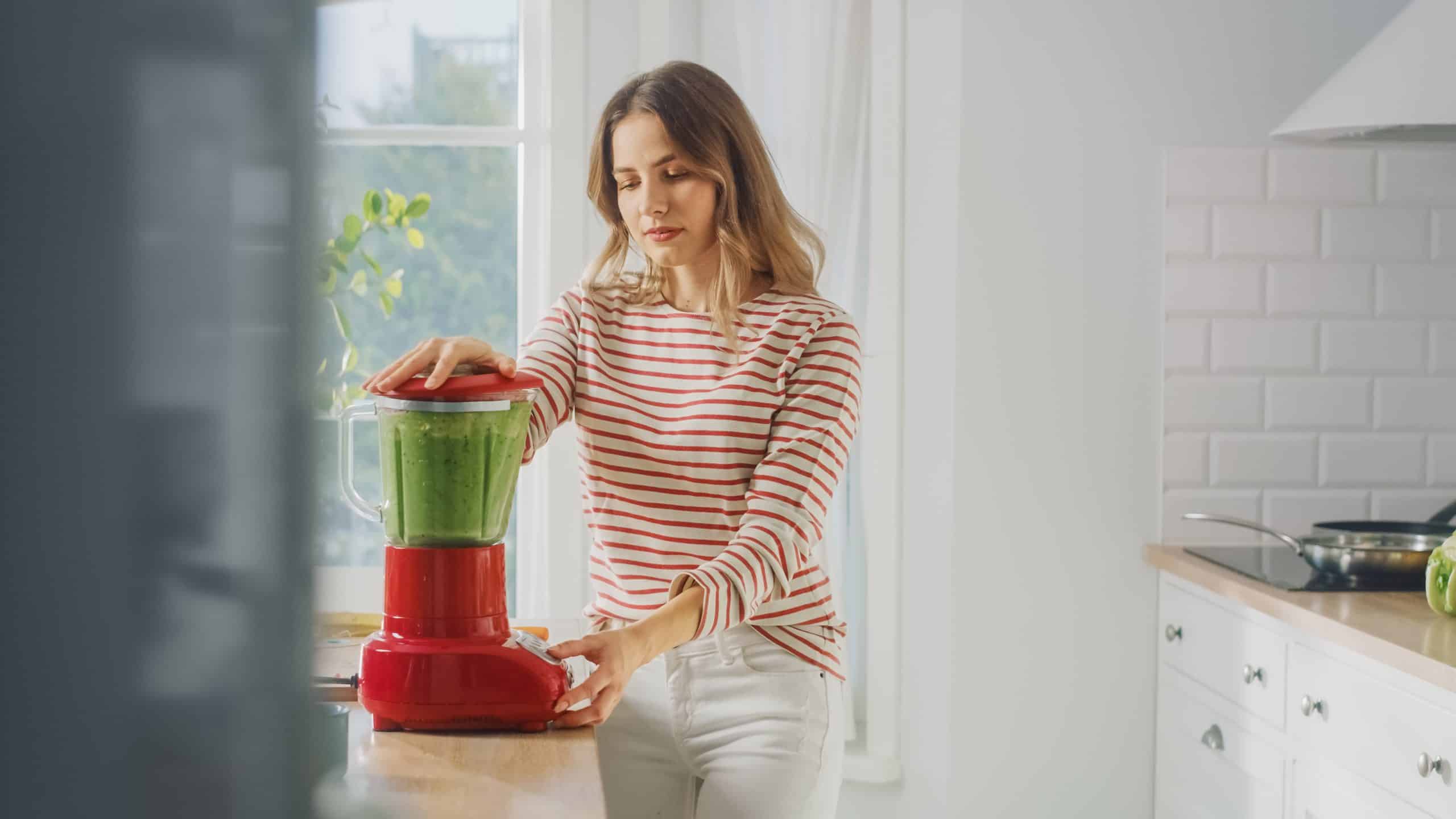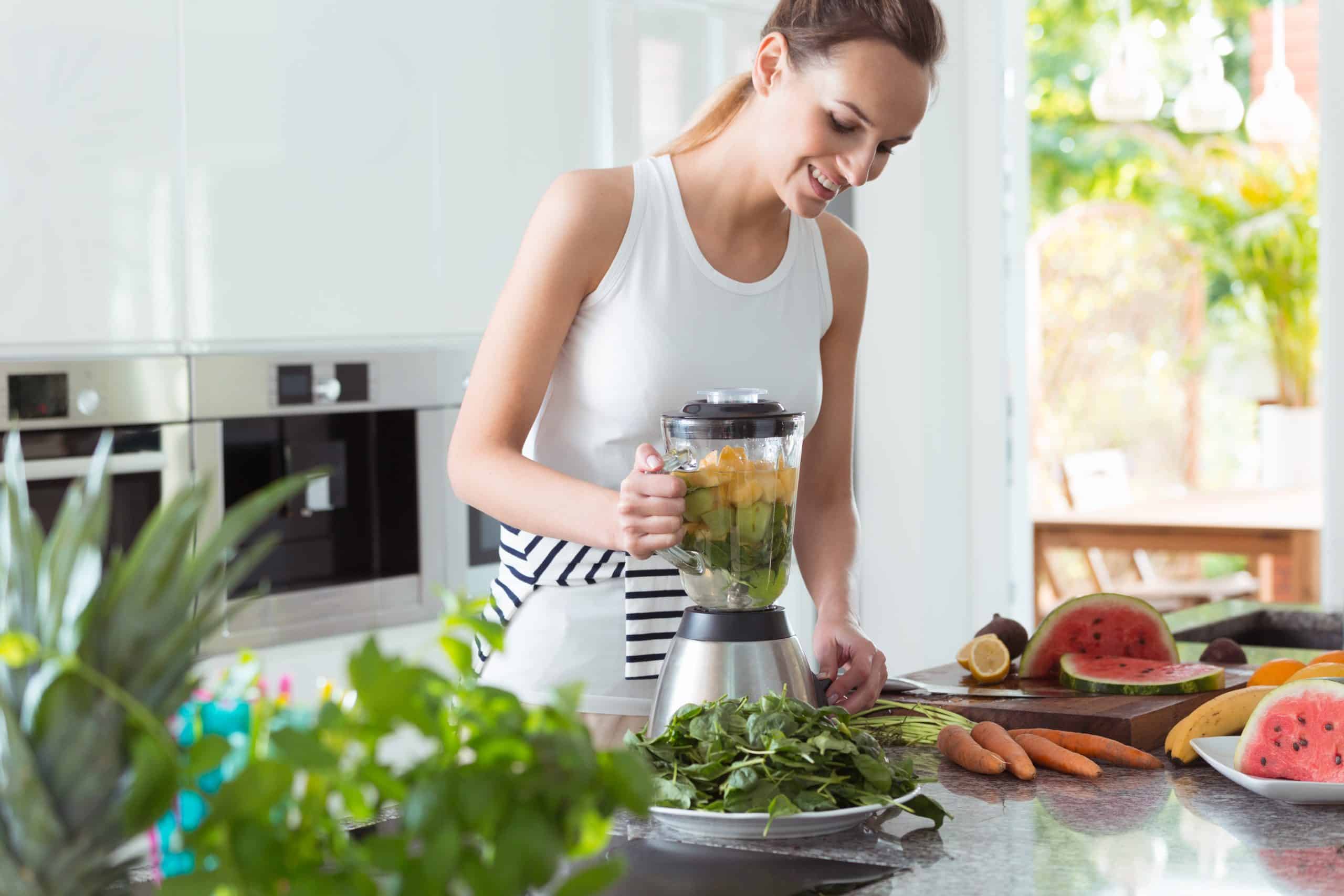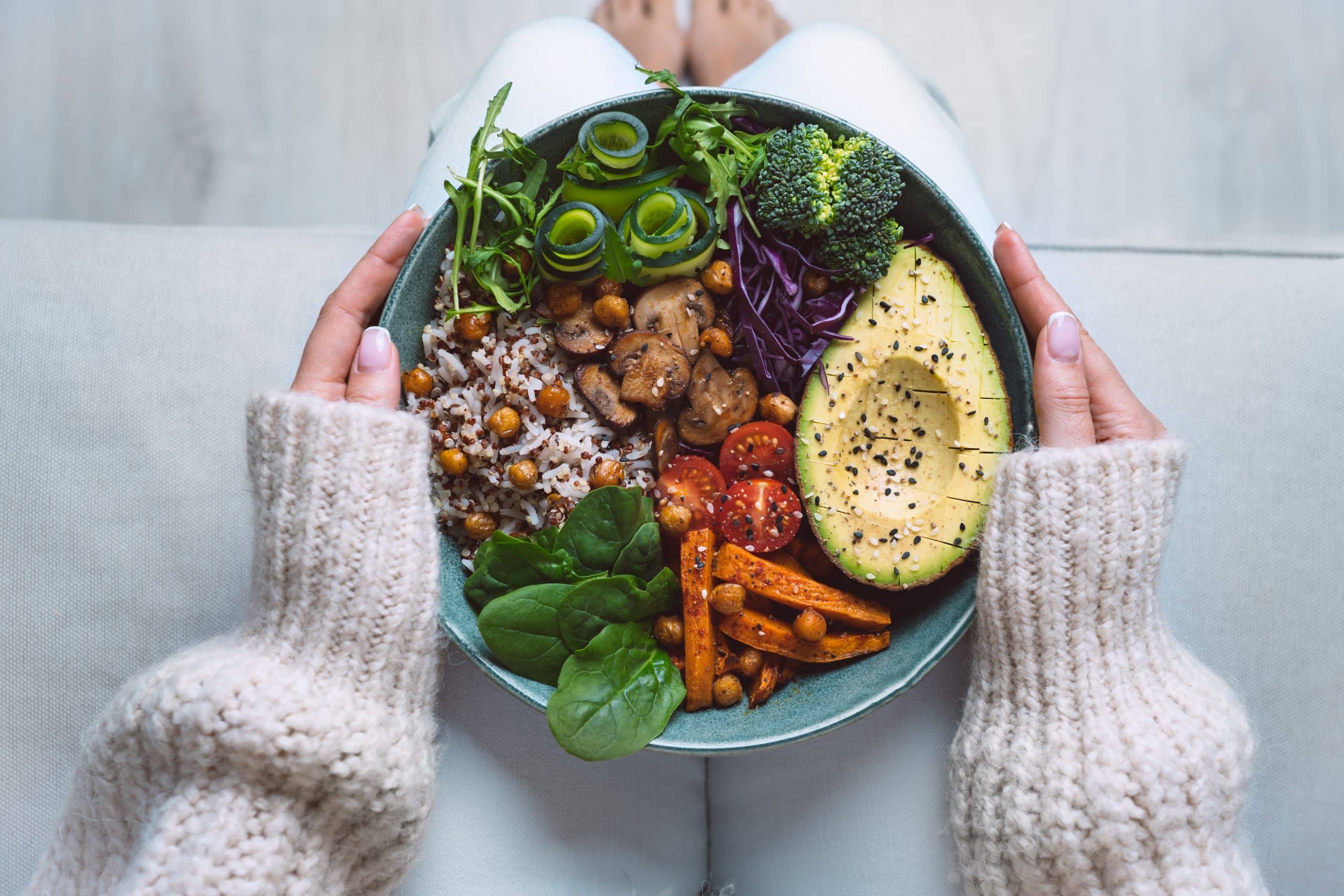In the modern fast-paced world, one beverage that’s pushing the boundaries of culinary innovation is the smoothie. Trendy and easy to make, smoothies form that one recipe that can be whipped up easily and completed in under a minute. The convenience they offer and the nutrition they can provide have earned smoothies the prestigious reputation of an on-the-go breakfast and a nutritious snack (14).
For many, the smoothie has transformed into a diet in itself. With careful curation of its ingredients, you can supplement your meals with this coveted beverage. The ingredients in your smoothie will inevitably influence your nutritional value and calorie intake. Healthier picks lead to a healthier you – the math is simple.
In this article, we’ll discuss the smoothie diet plan. We’ll comprehensively examine what it involves, its effectiveness, and how you can start such a diet plan. Take a look to determine if this diet plan is worth a shot.
What Is a Smoothie Diet Plan?
A smoothie refers to a blended drink prepared with ingredients such as fruits and vegetables. A smoothie diet plan refers to the creation of a meal plan that involves smoothies.
These diet plans will require you to get some of your calories from these blended drinks. There are many types of smoothies, which means the calories you attain from each drink will differ. To make sure that you get the most from such a diet plan, remember to first talk with your doctor.
You may not get the results you want from such a diet plan without any professional advice or help. So before you implement any diet plan, always remember to consult for both medical and professional guidance and assistance.
How Long Can You Be on a Smoothie Diet?
A smoothie diet plan is an example of a liquid diet plan. Experts acknowledge that most healthcare providers will recommend such a meal plan for only a short period of time (11). This is particularly true when you replace two meals per day with smoothies and then eat one modest meal and two snacks.
If you’re considering this diet plan as your reduced-calorie plan, many people try it for roughly three months (2). Such a duration is believed to be safe for otherwise healthy people and can help you achieve weight loss, especially if this is your intended goal. Note that such a diet plan must only be implemented if it’s first discussed with your doctor.
BetterMe is your fast-track ticket to a long-lasting weight loss! Tailor your fitness journey and maximize your results with just a couple of swipes!
Why Start Such a Diet Plan?
Usually, you may want to have a smoothie when you want to satisfy your sweet tooth using something healthy and nutritious. Otherwise, you may choose to have these drinks when you’re looking for a naturally filling snack. You don’t have to go on a smoothie diet plan in order to enjoy a smoothie here and there.
In addition, there are other reasons why people want to start a smoothie diet plan. In this case, you must first get the go-ahead from your doctor and you may need to consult a registered dietitian. It can be tricky to get all the nutrients you need when replacing all or most of your meals with liquids. Here are some solid reasons why a healthcare provider may recommend this plan, or why you can consider starting this diet plan, or simply incorporating a smoothie into your normal diet from time to time:
-
It Helps Increase Your Fruit and Vegetable Consumption
One excellent trait of smoothies is that they specifically incorporate fruits and vegetables. So, if you’re not eating enough of these, your doctor may suggest trying smoothies to increase your consumption. They will most likely suggest that you incorporate a smoothie as a snack, while still eating 3 solid meals per day. This will help with making sure that you get enough calories.
The good thing is you can blend the two ingredients and still make them taste good. All you need to do is find a perfect combination that works just right for your taste buds. In addition to increasing your fruits and vegetables, consuming the two together can also help reduce your risk of chronic diseases. Experts also state that fruit and vegetable consumption can help you maintain a healthy body weight (12).
-
It Helps Increase Your Fiber Intake
When you blend your fruits and vegetables, your smoothie tends to be rich in fiber and healthy phytonutrients. Fiber helps increase satiety (10). The advantage of this is that you feel full longer and as a result eat and snack less. This is quite important if you want to shed some extra pounds.
Similarly, fiber is significant in fighting poor digestion. Fiber helps prevent poor digestion and some complications such as constipation. As your smoothie uses fruits and vegetables, it can help you meet your daily fiber requirements. However, many experts believe that it’s better to eat your fruits and vegetables in their whole form to get the maximum benefits from their fiber content.
-
It May Help Increase Your Bone Strength
Some of the ingredients you use in your smoothies come in handy when it comes to bone strength. Using leafy green vegetables such as kale and spinach gives your body vitamin K1 (5). According to research, this vitamin decreases your risk of osteoporosis, bone fractures, and low bone mineral density. Some common smoothie ingredients are also rich in calcium, a mineral that can help support strong bones.
-
It Supports Your Immunity
Incorporating smoothies in your diet can also help support your immunity. The reasoning behind this is that most smoothies, particularly green smoothies, highly incorporate fruits and vegetables. Many of these are rich in vitamin C and other vitamins and minerals, which can help support your immune system. Vitamin C also helps fight infection and maintain healthy cellular functioning throughout your body (5).
Read more: 24 Weight Loss Smoothies, 2 Diet Plans, and 5 Belly Fat Smoothie Secrets
-
It Can Promote Weight Loss
Perhaps the most common reason why people start such a diet plan is due to its potential to promote weight loss. Theoretically, the key to weight loss is eating fewer calories than you use. This means you must be aware of your required daily calories.
Your daily calorie goal is influenced by aspects such as your sex, activity level, and age. Generally, health authorities state that women between 19 and 51 years require approximately 1, 800 to 2, 400 calories daily (1).
Men in the same age bracket require roughly 2, 200 to 3, 000 calories daily. After you learn about your suggested calorie level, you can work toward eating fewer calories to lose weight.
It is also suggested that you start by cutting 500 calories out of your daily requirements (1). This can help you lose up to a pound in a week.
When you replace a meal with a smoothie, chances are you’ll consume fewer calories. With this knowledge, you can work toward creating a smoothie diet plan that cuts 500 calories out daily. Be very careful to avoid limiting your diet plan to diets that provide fewer than 1,200 calories daily. These may not provide enough nutrients and can have side effects.
The Downside of a Smoothie Diet Plan
For the most part, you’ll be better off with such a diet plan if you only replace one meal or snack per day with a smoothie. If you replace more meals with smoothies, it’s best not to do so for too long a duration. Always talk to your doctor before you make significant changes to your diet. A smoothie diet can be inadequate in certain essential nutrients, and also comes with risks such as:
-
High Blood Sugar Levels
Remember that some smoothie recipes will ask you to use some sweeteners or added sugars. Too many added sugars can have detrimental effects on your health. They may increase your risk of chronic disease and tooth decay. Although fruits contain natural sugars, these are not a concern. However, if you have diabetes or impaired blood glucose control, be aware that added sugars in your smoothies can increase blood sugar levels (5).
-
Overconsumption
Overconsumption is always a potential hidden danger when it comes to the smoothie diet plan. It can be easy to forget portion control when it comes to such a diet plan. We can forget that these drinks contain calories, which we should be cautious of if the goal is weight loss.
For effective smoothie diet weight loss results, you must be cautious of your servings. No matter how good your smoothie tastes, try to stick to the recommended servings. It’s also essential to look at your diet as a whole and how your smoothie fits into it.
If you’ve mustered up the courage to crush your weight loss goal, let Betterme take the sting out of this demanding process. Our app will help you restructure your habits, remold your life and crank up your fitness results!
How to Create a Practical Smoothie Diet Plan
It’s incredibly important to take time and create a smoothie diet plan instead of just implementing one you found online. The advantage of such a move is that you get to prepare your diet plan the right way. You also get to use the right ingredients to help you design it to meet the intended purpose. Here’s a checklist detailing vital aspects you must consider to make a healthy smoothie diet:
-
Your Intended Goals
There are several reasons why people choose to start a smoothie diet plan. For some, the goal is to increase their vegetable and fruit intake. In this case, their diet plan will lean more toward smoothies prepared from such ingredients.
Another goal could be to use this diet plan to promote weight loss. Again, there may be a shift in the ingredients used. There will tend to be more of those products that can support weight loss by providing fewer calories. That being said, be specific about what you want to accomplish with such a diet plan. This plays a crucial role in determining the ingredients of your smoothies.
-
Your Calorie Limit
As previously mentioned, you must be aware of your daily calorie intake. Such knowledge will help create a low-calorie smoothie diet plan if your goal is weight loss. It will guide you on how to use more low-calorie fruits and vegetables to make weight loss more achievable (8).
-
Your Ingredients
In a perfect world, the last thing we should be worried about is what we eat. After all, such a perfect world would not entail adding extra pounds after eating too much of certain foods. However, this doesn’t exist.
In the real world, what we eat highly influences our body weight. You must be mindful when creating your smoothie diet plan and include foods that help you maintain a healthy body weight by being rich in nutrients but relatively low in calories.
Some of the healthy food options you can consider include (13):
-
Healthy fats
Fats help increase your satiety levels. You can add healthy fats to your smoothies from sources such as chia seeds, avocado, peanut butter, and raw walnuts. Keep track of how much of these fats you use as they contribute significant calories, but in the right portion sizes, they’re great smoothie additions.
-
Proteins
You also need proteins in your smoothie to help boost your satiety and help you maintain lean muscle mass. You can use protein sources such as almonds, unsweetened Greek yogurt, whey, and pea protein.
-
Carbs
A healthy smoothie also has some healthy complex carbs. Some people target 15 g of carbs in their smoothies, particularly if it is more of a snack. If it replaces a meal, more carbs would be appropriate. Good sources of carbs in smoothies include ingredients such as half a banana, a three-quarter cup of blueberries, or half a cup of granola (13).
What Kinds of Smoothies Can Fit a Smoothie Diet Plan?
There are numerous smoothie recipes you could choose to include in such a diet plan. However, your personal goals will influence how you implement this diet plan. For example, you probably won’t include high-calorie smoothie recipes if your goal is weight loss. Let’s look at some smoothie recipes you can include depending on various goals.
-
Keto
Keto has become quite popular in the fitness world as some people have successfully lost weight on the keto diet plan. Some experts believe that the keto diet can promote weight loss by reducing your appetite and boosting your metabolism (17). If you’re on a ketogenic diet and still need a smoothie, then here are some keto smoothie recipes to consider:
The Chocolate Mint Avocado Smoothie Recipe
The following keto smoothie recipe makes one serving and contains only two grams of net carbs (15).
Ingredients
- One cup water, half cup coconut milk, two scoops chocolate flavor collagen protein powder, half a frozen avocado, four mint leaves, one tablespoon crushed cacao butter, two tablespoons shredded coconut, and half a cup of ice.
Preparation
- Mix all the ingredients in a blender apart from the collagen protein powder and shredded coconut. After blending the other ingredients, add the collagen protein and quickly blend. You’ll use the coconut as the topping of this drink.
Nutritional Value
-
- Calories – 552
- Total fats – 44 g
- Total carbs – 10 g
- Protein – 26 g
The Keto Avocado Smoothie with Coconut Milk, Ginger, and Turmeric
This recipe is also from the Medical News Today Website (12). The ginger and turmeric added to this drink have antimicrobial anti-inflammatory and antioxidant properties. This is an excellent dairy-free or vegan smoothie option. It is as follows:
Ingredients
- Half an avocado, a three-quarter cup of full-fat coconut milk, one teaspoon of freshly grated ginger, half a teaspoon of turmeric, a quarter cup of almond milk, one teaspoon of lime or lemon juice, one cup of crushed ice, and a sugar-free sweetener to taste.
Preparation
- Blend all the ingredients until you get a thick puree.
Nutritional Information
The recipe is for two servings. The nutritional value of one serving is as follows:
- Calories – 232
- Total fats – 22.4 g
- Protein – 1.7 g
- Carbs – 6.9 g
Weight Loss
There are no quick fixes when it comes to weight loss. Weight loss generally means that you need to maintain a calorie deficit, exercise regularly, and eat healthily. There’s no particular beverage that can magically lead to weight loss (16).
However, there are some drinks such as weight loss smoothies that may support the required lifestyle changes to promote weight loss. Most weight loss smoothies tend to contain low calories. If you’re considering a low-calorie smoothie diet plan, consider the following smoothie recipes:
Read more: Are Smoothies Good For Losing Weight? What Experts Say
The Green Smoothie
When you think of the green smoothie, perhaps you picture something unappetizing. You perhaps think of this due to its color and texture. However, the green smoothie is quite delicious, especially if you use a sweetener such as a banana. Here is a simple and delicious green smoothie recipe that supports a healthy lifestyle for weight loss (4):
Ingredients
- One banana, four tablespoons of lemon juice, half a cup of strawberries, half a cup of other berries such as blueberries or blackberries, two ounces of fresh raw baby spinach, one cup cold water or ice, and fresh mint to taste.
Preparation
- Put all the ingredients in your blender and mix to get your drink.
Nutritional Information
The recipe has a serving size of at least six fluid ounces. The nutritional content of one serving is as follows:
- Calories – 64
- Total carbohydrates – 12 g
- Fiber – 2 g
- Cholesterol – 0 mg
- Protein – 1 g
- Total fat – Trace
- Sodium – 15 mg
- Total sugars – 7 g
- Added sugars – 0 g
Maintaining a Healthy Body Weight
If you’re starting such a diet plan to maintain a healthy body weight, you can consider the following recipe. It is from the Mayo Clinic website and is a perfect breakfast smoothie diet plan consideration. It’s low in protein, so consider pairing it with an omelet or another protein-rich food for a balanced meal. It is as follows (3):
Ingredients
- One cup fresh pineapple chunks, half a cup cantaloupe or any other melon chunks, one cup fresh strawberries, juice of two oranges, one cup of cold water, and one tablespoon of honey
Preparation
- Place all the ingredients in your blender and puree until you get a drink with the desired consistency
Nutritional Information
This recipe accounts for a serving size of eight ounces. The nutritional information of one serving is as follows:
- Calories – 72
- Cholesterol – 0 mg
- Fiber – 1 g
- Total carbs – 17 g
- Sodium – 17 mg
- Protein – 1 g
- Total fat – 0 g
- Total sugars – 13 g
- Added sugars – 4 g
Tips for Making Weight Loss Smoothies
- Portion Control: Use measuring cups to ensure you’re not adding too many high-calorie ingredients.
- Balance Macronutrients: Include a mix of carbohydrates, protein, and fats to keep you full longer.
- Limit Added Sugars: Use natural sweeteners such as fruit or limit to a small amount of added sugar if necessary.
- Incorporate Greens: Adding spinach or kale increases fiber and nutrients without significantly altering taste.
- Use a Liquid Base: Opt for water, unsweetened almond milk, or coconut water instead of fruit juices.
FAQs
Can you lose weight by drinking smoothies?
Yes, you can lose weight by replacing some meals or snacks with smoothies if they’re made with nutrient-intensive, low-calorie ingredients and consumed as part of a balanced diet. Smoothies can help control hunger and reduce overall calorie intake. Including a mix of fruits, vegetables, protein, and healthy fats can make them filling, nutritious, and tasty, consequently helping with weight loss.
For example, a smoothie made with spinach, banana, Greek yogurt, and chia seeds provides essential nutrients while keeping the calorie count low. However, it’s important to ensure that smoothies don’t become a vehicle for excessive sugars or calories, which can counteract weight loss efforts. Monitoring your portion sizes and ingredient choices is absolutely mandatory. It’s also not a good idea to replace too many meals with liquids such as smoothies or shakes, or to do so for an extended period of time.
What is the 21-day smoothie diet?
The 21-day smoothie diet is a weight loss plan where individuals replace two of their daily meals with smoothies for a total of 21 days. The plan typically includes recipes for smoothies that are high in fiber, protein, and essential nutrients while being low in calories. The goal is to initiate weight loss by reducing calorie intake and increasing the consumption of fruits and vegetables.
By utilizing a broad spectrum of nutrients, diet adherents can avoid the monotony that can creep up for a diet like this. Along with smoothies, participants are usually advised to eat one solid meal a day that is low in calories and high in nutrition. It is also recommended to consult a healthcare professional before starting this diet to ensure it meets individual health needs.
Which smoothie is best for weight loss?
The best smoothie for weight loss includes ingredients that are low in calories but high in fiber and protein to help you feel full longer. A typical weight-loss smoothie may include:
- Leafy greens (such as spinach or kale),
- Small portion of fruit (such as berries),
- A source of protein (such as Greek yogurt or protein powder)
- Healthy fats (such as avocado or chia seeds)
For example, a smoothie made with kale, blueberries, a scoop of protein powder, and a tablespoon of flaxseeds offers a balanced mix of nutrients. The fiber from the greens and berries helps keep you satiated, the protein supports muscle maintenance and growth, and the healthy fats provide sustained energy (7). This combination helps with weight loss and ensures the body receives the necessary nutrients
What should I not put in a smoothie for weight loss?
To keep a smoothie low in calories and conducive to your weight loss goals, avoid adding too many high-calorie ingredients such as (9):
- Sugary syrups or honey
- Full-fat dairy products
- Fruit juices
- Sweetened yogurt
- Excessive amounts of nuts or seeds
- Ice cream or frozen yogurt
These ingredients can make your smoothies high in calories, which can hinder weight loss if you end up going over your daily calorie goal consistently. Instead, you should opt for fruit as a natural sweetener, use unsweetened almond milk or water as a base, and choose plain, low-fat Greek yogurt for protein. By focusing on whole, minimally processed ingredients, you can create smoothies that support weight loss while still being delicious and satiatory.
Is it OK to just drink smoothies every day?
While it can be okay to drink a smoothie every day, it’s important to ensure they’re part of a balanced and varied diet. Relying solely on smoothies can lead to nutrient deficiencies. Including whole foods alongside smoothies is recommended to ensure you get a wide range of nutrients. Have a smoothie as a post-workout snack or a breakfast on the go, but don’t make them your whole diet.
Is replacing a meal with a smoothie healthy?
Replacing a meal with a smoothie can be healthy if the smoothie is well-balanced and contains a mix of protein, carbohydrates, fats, vitamins, and minerals. It’s essential that the smoothie provides enough calories and nutrients to serve as a meal replacement. For example, a smoothie made with spinach, banana, protein powder, almond butter, and chia seeds can be a nutritious meal replacement. However, it’s important to make sure this practice doesn’t become a long-term habit, as relying solely on smoothies can lead to nutrient imbalances.
Are smoothies good for your diet?
Smoothies can be a good addition to your diet if they’re made with healthy, nutrient-rich ingredients and consumed in moderation. They can help increase your intake of fruits and vegetables, provide a quick and convenient meal or snack option, and be tailored to meet specific dietary needs and preferences. When made properly and part of a balanced diet, smoothies can be an effective tool for improving overall diet quality and supporting health and wellness goals. However, they shouldn’t be used to replace healthy meals and snacks.
The Bottom Line
You can consider starting a smoothie diet plan for various reasons. It could be to lose weight, maintain a healthy body weight, or increase your fruit and vegetable intake. Whatever the case may be, always first seek help from a licensed healthcare provider. Remember to only try this diet plan for a short duration or as recommended by your doctor, and don’t replace too many of your meals with smoothies.
DISCLAIMER:
This article is intended for general informational purposes only and does not serve to address individual circumstances. It is not a substitute for professional advice or help and should not be relied on for making any kind of decision-making. Any action taken as a direct or indirect result of the information in this article is entirely at your own risk and is your sole responsibility.
BetterMe, its content staff, and its medical advisors accept no responsibility for inaccuracies, errors, misstatements, inconsistencies, or omissions and specifically disclaim any liability, loss or risk, personal, professional or otherwise, which may be incurred as a consequence, directly or indirectly, of the use and/or application of any content.
You should always seek the advice of your physician or other qualified health provider with any questions you may have regarding a medical condition or your specific situation. Never disregard professional medical advice or delay seeking it because of BetterMe content. If you suspect or think you may have a medical emergency, call your doctor.
SOURCES:
- Counting calories for weight loss (2017, medicalnewstoday.com)
- Diet Shakes: Sipping to Slimness (2008, webmd.com)
- Fresh fruit smoothie (2019, mayoclinic.org)
- Green smoothie (2018, mayoclinic.org)
- Green Smoothies: Are They Good for You? (2020, webmd.com)
- Health problems Related to Obesity (2020, webmd.com)
- How to Make a Healthy Smoothie (n.d., hopkinsmedicine.org)
- How to Use Fruits and Vegetables to help Manage Your Weight (2020, cdc.gov)
- Ingredients Nutritionists Never Put In Their Smoothies (2017, prevention.com)
- Is juicing healthier than eating whole fruits or vegetables? (2019, mayoclinic.org)
- Liquid Diet (2020, webmd.com)
- Smoothies: Are They Good for You? (2020, webmd.com)
- The best smoothies for people with diabetes (2019, medicalnewstoday.com)
- The Development of high protein, high fiber smoothie as a grab-and-go breakfast option (2017, ncbi.nlm.nih.gov)
- What are some of the top keto smoothie recipes to try? (2021, medicalnewstoday.com)
- What are the best drinks for losing weight? (2019, medicalnewstoday.com)
- Why is the keto diet good for you? (2020, medicalnewstoday.com)
